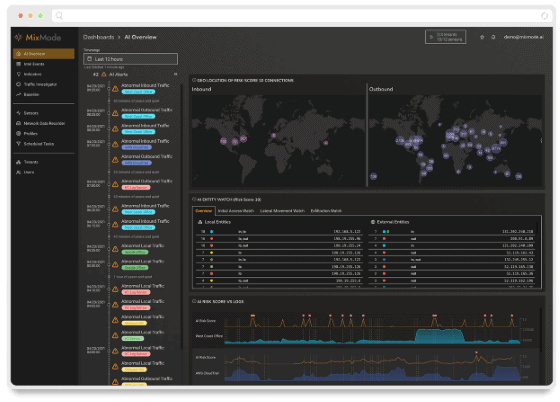Geoffrey is a cybersecurity business executive and leader with over 25 years of experience and a proven track record in sales and solutions across a wide variety of information security technologies, risk management, and regulatory compliance solutions. Geoffrey currently runs Strategic Alliances at MixMode and before coming to MixMode he ran large solutions teams at Splunk, Palo Alto Networks, and SAP.
Technology changes at a breakneck pace, and to be of any use, the security we rely on to protect that technology must change alongside it.
Cybersecurity solutions, in particular, must keep up with the evolving needs of hybrid enterprise networks that connect an ever-expanding mesh of cloud devices, on-prem legacy hardware and everything in between.
The next cybersecurity challenge lies with the advances in quantum computing that are set to revolutionize tech while simultaneously equipping threat actors with a new arsenal of cyberweapons.
Cybersecurity and the Fourth Industrial Revolution
The fourth industrial revolution is upon us. It’s a bold claim — are we really about to usher in an era as potentially impactful as the steam engine, the age of science and mass production and the initial rise of digital technology?
Well, yes. According to several high-profile industry experts who spoke at the Consumer Electronics Show (CES) 2021, advances in artificial intelligence (AI) and quantum computing are set to fundamentally change the way the world engages with technology.
As an emerging concept, the high-level technology industry has yet to arrive at a fully-consistent definition, but widespread consensus points to a focus on several key elements. The fourth industrial revolution will be marked by fundamental advances and interconnectivity between fields like:
- AI
- 5G
- Robotics
- 3D-printing
- IoT
Tying them all together is quantum computing, which we can define as…well, it’s not particularly simple to explain quantum computing for most of us. Even MIT, while trying to “explain it like we’re five years old,” refers to quantum computing as technology that harnesses some of the “almost-mystical” phenomena of quantum mechanics.
Still, it’s good to develop a high-level understanding so that we can view the impact on cybersecurity within a more informed context. The MIT explainer referenced above offers a relatively-accessible introduction, as does this Microsoft Azure guide. Without diving deep into a course on qubits, superposition and entanglement, however, we can also gain insight by considering how enterprises are already using quantum computing.
Volkswagen and Daimler, for example, are using quantum “supercomputers” to improve electric vehicle batteries based on chemical simulations. Simulating, at a molecular level, the behavior of matter is one way we will fundamentally change our approach to problem-solving in the age of quantum computing.
So What Does Quantum Computing Have to Do with Network Cybersecurity?
Quantum computing is based on technology we’ve yet to fully harness. However, the same constant remains true when it comes to bad actors: whatever the “good guys” understand about quantum computing, the “bad guys” do, too.
Unfortunately, there will always be an army of cyber criminals standing by, ready to apply their knowledge and talents to nefarious activity. It’s safe to say that vulnerabilities will plague quantum systems just as they’ve plagued every other “next generation” system.
In order for cybersecurity solutions to adequately guard quantum networks, they will need to address several key factors:
- How cryptography will be impacted by quantum random number generation
- Quantum key distribution (QKD) capabilities, which will provide much more secure encrypted communications
- Public-key cryptography implications — quantum computing could lead to breaking foundational digital infrastructure like the RSA algorithm, which we depend on to run our $4 trillion ecommerce industry
- Addressing the on-going shortage of cybersecurity professionals
While each of these issues will require specific high-level and granular solutions, networks equipped with true self-learning AI capabilities will fare better when monitoring network activity, even as it occurs at whirlwind, quantum speeds.
MixMode Empowers Modern Systems to Confront Modern Threats
MixMode’s predictive, proactive, efficient AI gives organizations a fighting chance at combating modern actors. Rules-based approaches are doomed to fail against cyberthreats in the quantum space.
On one level, it’s a simple matter of speed. The systems of tomorrow (and many of the systems of today) will move too quickly for modern SOCs to keep their security platforms up-to-date. Context-aware AI must “live” within enterprise systems in order to detect anomalies as they occur in such rapidly changing environments.
MixMode is ready to face quantum threats by thriving within quantum networks. MixMode is data- and feed-agnostic — it can operate effectively and independently regardless of data format and type.
As systems rapidly expand and scale to allow for the increased data inputs organizations will need to monitor. For example, we can expect an influx of 5G-enabled IoT sensors and increased remote connections among a workforce forever changed by the 2020 pandemic.
Because MixMode’s third-wave, self-supervised AI doesn’t need constant babysitting or continual rules-tweaking, the platform will protect quantum systems with an approach proven to identify threats and anomalies in network traffic, log systems, API, time-series, cloud data, and beyond.
Learn more about MixMode and set up a demo today.
MixMode Articles You Might Like:
How a Government Entity Switched to MixMode and Decreased Data Storage Costs by 50%
2021: The Year SOCs Embrace Cybersecurity Convergence
Why Responding to a Cyber Attack with a Traditional SIEM Leaves You Vulnerable


